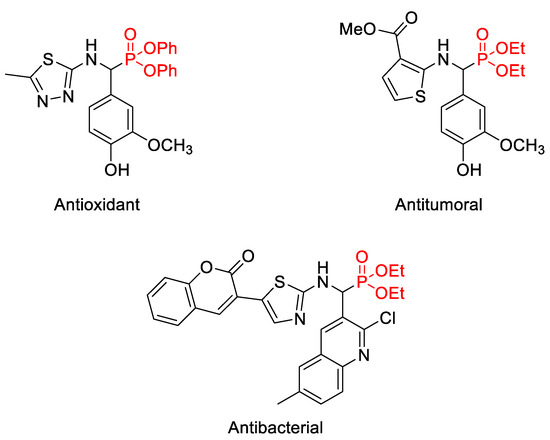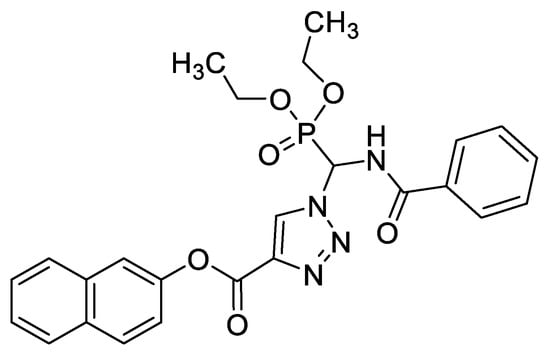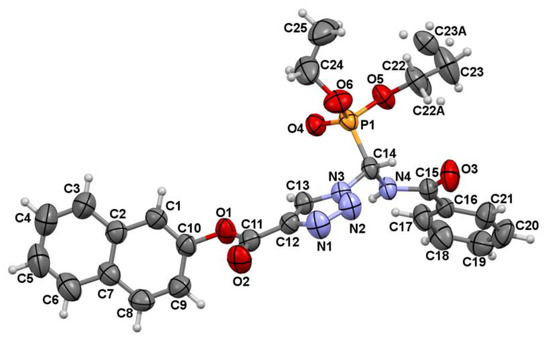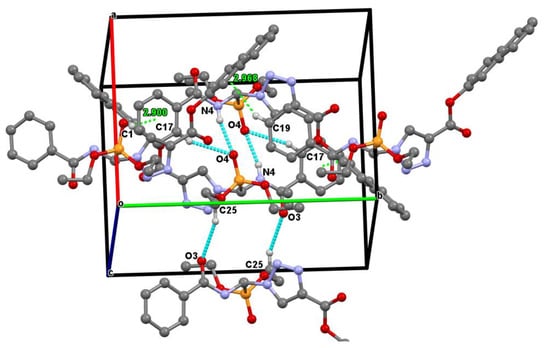Abstract
We have previously published on a new triazolic phosphonic α-amino ester in position 4 on the triazole ring of a naphthalene ester. The aim of the present paper was to describe its crystallographic study by XRD. The crystal structure of naphthalen-2-yl 1-(benzamido(diethoxyphosphoryl)methyl)-1H-1,2,3-triazole-4-carboxylate was determined by single-crystal X-ray diffraction. This compound crystallizes in the monoclinic system, space group P21/c. The naphthalene system is almost planar and makes dihedral angles of 67.1(2)° and 63.9(2)° with the triazole ring and the phenyl cycle, respectively. The phosphorus atom is surrounded by three oxygen atoms and one carbon atom building a distorted tetrahedron. It is also noted, that one of the two ethyl groups is disordered. In the crystal, the molecules are connected through C-H…O and N-H…O hydrogen bonds to build dimers that are linked together by C-H…O hydrogen bonds, in addition to C-H…π interactions. The presence of an intramolecular hydrogen bond contributes to the stability of the molecular conformation by completing the S(5) cycle.
1. Introduction
Organophosphorus compounds, especially α-aminophosphonates and their ester derivatives present a great research focus due to their wide range of pharmacological and environmental applications [1]. Being recognized as bioisosteres [2] of amino acids, α-aminophosphonates can be inhibitory agents of enzymes or receptor ligands due to the tetrahedral arrangement of these substituents around the phosphorus atom, which allows them to mimic the energetic transition state of peptide bond hydrolysis during metabolic processes [3,4]. These compounds have been shown to have excellent properties as inhibitors of GABA receptors, various proteolytic enzymes, dialkylglycine decarboxylase and peptide mimetics [5]. It is with this in mind that organic chemists are now focusing their attention on the synthesis of new models of heterocyclic aminophosphonates. These last ones, according to our research, have been evaluated and given very interesting biological activities as anticancer [6,7], antimicrobial [8], antioxidant [9] agents (Figure 1).

Figure 1.
Biological activity of some heterocyclic α-aminophosphonates.
In contrast to the multi-component Kabachnick-fields method, which is the most common one for the synthesis of heterocyclic aminophosphonate derivatives [10,11,12], we recently reported the synthesis of two new bi-heterocyclic α-aminophosphonate compounds based on the 1,3-dipolar cycloaddition method by click chemistry [13,14]. This method invites interest for its use as a less toxic reagent and solvent but especially for its regioselectivity by giving the 1,4-regioisomer.
After having reported the characterization by 1D and 2D-NMR spectroscopic techniques and high-resolution mass spectrometry of the title compound, naphthalen-2-yl 1-(benzamido(diethoxyphosphoryl)methyl)-1H-1,2,3-triazole-4-carboxylate (1) [14] (Figure 2), we show in this paper its crystallographic study by XRD.

Figure 2.
Chemical diagram for the title compound (1).
2. Results and Discussion
The triazolic phosphonic α-amino ester product (1) is resynthesized with an excellent yield of about 95% and high regioselectivity via the copper I-catalyzed alkyne-azide cycloaddition reaction (CuAAC), using diethyl (-azido(benzamido)methyl)phosphonate as the dipole and 2- naphthyl propiolate as the dipolarophile [14]. A single crystal of the title compound was obtained by recrystallization from ethanol. The title compound, C25H25N4O6P, crystallizes in the monoclinic system, space group P21/c. The structure is built from two fused six-member rings linked through a carboxylate group to the triazole ring, which is connected to a benzamido ring and to diethoxyphosphoryl methyl as shown in Figure 3. In the structure of this molecule, the naphthalene system is quasiplanar with a maximum deviation from the mean plan of −0.010(3) at the C8 atom. The plane through the triazole ring makes dihedral angles of 67.1(2)° and 56.0(2)° with the naphthalene system and the phenyl ring, respectively. Moreover, the dihedral angle between the naphthalene plan and the phenyl cycle is 63.9(2)°. The phosphorous cation is connected to three oxygen atoms with P–O distances between 1.453 (2) Å and 1.551 (2) Å, in addition to one carbon atom at 1.824(3) Å. The three oxygen atoms and the carbon build a distorted tetrahedron surrounding the phosphorous atom. Furthermore, the structure is characterized by disorder in the ethyl group connected to the O5 atom, which is distributed over two positions. The refinement of the occupancy rate of the two ethyl groups leads to the present model.

Figure 3.
Plot of the molecule of the title compound with the atom-labelling scheme. The ethyl group connected to O5 is split. Displacement ellipsoids are drawn at the 50% probability level. H atoms are represented as small circles.
In the crystal, the molecules are interconnected through C17–H17…O4 and N4–H4A…O4 bifurcated hydrogen bonds that build dimers (Figure 4). The dimers are linked together by the C25–H25…O3 hydrogen bond, in addition to C1–H1…π and C19–H19…π interactions (See Supplementary Materials Table S2). Moreover, the molecular conformation is stabilized by a stark intramolecular hydrogen bond (C14–H14…O3) completing the S(5) ring (see Table S2).

Figure 4.
Crystal packing for the title compound showing hydrogen bonds as dashed blue lines and C–H…π interactions as dashed green lines.
3. Materials and Methods
An appropriate single crystal was carefully selected using a polarizing microscope for X-ray data collection at room temperature using Bruker D8 Venture Super DUO diffractometer with PHOTON100 CMOS area-detector and monochromatic MoKα radiation (λ = 0.71073 Å). APEX3 [15] software was used for data collection, and the absorption correction was performed by a multi-scan, semi-empirical method using SADABS [16]. The crystal structure was solved by the direct method and refined by a weighted full matrix least-square on F2 techniques using the programs SHELXT 2014 [17] and SHELXL 2018 [18] incorporated in the WinGX program [19]. For the structural drawing, MERCURY software was used [20]. Non-hydrogen atoms were refined with anisotropic thermal parameters. The C-bound H atoms were geometrically placed (C–H = 0.93–0.98 Å) and refined as riding with Uiso(H) = 1.2–1.5 Ueq(C). The O-bound H atom was located in a different Fourier map and refined freely.
Crystal Data for C25H25N4O6P (M = 508.46 g/mol): monoclinic, space group P21/c, a = 10.6281(8), b = 14.2828 (10), c = 16.5913 (12) Å, β = 91.946 (3)°, V = 2517.1 (3) Å3, Z = 4, T = 296 K, µ(MoKα) = 0.16 mm−1, Crystal size (mm3) = 0.32 × 0.28 × 0.19, Index ranges: −13 ≤ h ≤ 13, −18 ≤ k ≤ 18, −18 ≤ l ≤ 21, 61,924 reflections measured, Ө range for data collection (°): 2.4 to 27.1. Full crystallographic information (as CIF file) along with CheckCIF report are given in the Supplementary Materials.
4. Conclusions
In summary, we obtained the X-ray crystal structure of the product described previsouly, the naphthalen-2-yl 1-(benzamido(diethoxyphosphoryl)methyl)-1H-1,2,3-triazole -4-carboxylate and found its structure to be characterized by disorder in the methyl linked to an ethyl attached to the phosphorus group. The three oxygen atoms and the carbon build a distorted tetrahedron surrounding the phosphorous atom. Furthermore, the naphthalene system is almost planar and makes dihedral angles.
Supplementary Materials
The following supporting information can be downloaded at website. Figure S1: Crystallography data for title compound (1); Table S1: Crystal data and structure refinement for title compound (1); Table S2: Fractional atomic coordinates and isotropic or equivalent isotropic displacement parameters (Å2); Table S3: Atomic displacement parameters (Å2); Table S4: Geometric parameters (Å,°); Table S5: Geometric parameters (Å,°) for (shelx).
Author Contributions
S.A.K.F. performed the experiments; Y.A., S.H. and A.A. (Anouar Alami) conceived and designed the experiments; R.O., M.E.O., A.A. (Abderrazzak Assani), M.S. and L.E.A. carried out the X-ray analysis and solved the structure, Y.A., R.O. and A.A. (Anouar Alami) wrote the paper. All authors have read and agreed to the published version of the manuscript.
Funding
This research received no external funding.
Institutional Review Board Statement
Not applicable.
Informed Consent Statement
Not applicable.
Data Availability Statement
The data presented in this study are available in the Supplementary Materials.
Acknowledgments
This work was supported by Sidi Mohammed Ben Abdellah University (USMBA) and National Center for Scientific and Technical Research (CNRST). The authors thank the Faculty of Science, Mohammed V University in Rabat, Morocco, for the X-ray measurements.
Conflicts of Interest
The authors declare no conflict of interest.
References
- Abdeen, M.; Hamed, M.; Aleem, A.; Nassar, I.; El-Sayed, I. A comparative study of metal-catalyzed three-component synthesis of α-aminophosphonates. Curr. Chem. Lett. 2021, 10, 221–234. [Google Scholar] [CrossRef]
- Steere, J.A.; Sampson, P.B.; Honek, J.F. Synthesis of an α-aminophosphonate nucleoside as an inhibitor of S-adenosyl-l-homocysteine hydrolase. Bioorg. Med. Chem. Lett. 2002, 12, 457–460. [Google Scholar] [CrossRef]
- Viveros-Ceballos, J.L.; Matías-Valdez, L.A.; Sayago, F.J.; Cativiela, C.; Ordóñez, M. New approaches towards the synthesis of 1,2,3,4-tetrahydro isoquinoline-3-phosphonic acid (TicP). Amino Acids 2021, 53, 451–459. [Google Scholar] [CrossRef] [PubMed]
- Sienczyk, M.; Oleksyszyn, J. Irreversible inhibition of serine proteases-design and in vivo activity of diaryl alpha-aminophosphonate derivatives. Curr. Med. Chem. 2009, 16, 1673–1687. [Google Scholar] [CrossRef] [PubMed]
- Grembecka, J.; Mucha, A.; Cierpicki, T.; Kafarski, P. The most potent organophosphorus inhibitors of leucine aminopeptidase. Structure-based design, chemistry, and activity. J. Med. Chem. 2003, 46, 2641–2655. [Google Scholar] [CrossRef] [PubMed]
- Abdelwahed, R.E.; Radhi, A.H.; Awad, H.M.; El Gokha, A.A.; Goda, A.E.-S.; El Sayed, I.E.-T. Synthesis and anti-proliferative activity of new α-amino phosphonate derivatives bearing heterocyclic moiety. Pharm. Chem. J. 2021, 55, 231–239. [Google Scholar] [CrossRef]
- Ma, J.; Li, J.; Guo, P.; Liao, X.; Cheng, H. Synthesis and antitumor activity of novel indole derivatives containing α-aminophosphonate moieties. Arab. J. Chem. 2021, 14, 103256. [Google Scholar] [CrossRef]
- Litim, B.; Djahoudi, A.; Meliani, S.; Boukhari, A. Synthesis and potential antimicrobial activity of novel α-aminophosphonates derivatives bearing substituted quinoline or quinolone and thiazole moieties. Med. Chem. Res. 2022, 31, 60–74. [Google Scholar] [CrossRef] [PubMed]
- Azaam, M.M.; Kenawy, E.-R.; El-din, A.S.B.; Khamis, A.A.; El-Magd, M.A. Antioxidant and anticancer activities of α-aminophosphonates containing thiadiazole moiety. J. Saudi Chem. Soc. 2018, 22, 34–41. [Google Scholar] [CrossRef]
- Tlidjane, H.; Chafai, N.; Chafaa, S.; Bensouici, C.; Benbouguerra, K. New thiophene-derived α-aminophosphonic acids: Synthesis under microwave irradiations, antioxidant and antifungal activities, DFT investigations and SARS-CoV-2 main protease inhibition. J. Mol. Struct. 2022, 1250, 131853. [Google Scholar] [CrossRef]
- Dai, Y.; Zheng, L.; Chakraborty, D.; Borhan, B.; Wulff, W.D. Zirconium-catalyzed asymmetric Kabachnik–Fields reactions of aromatic and aliphatic aldehydes. Chem. Sci. 2021, 12, 12333–12345. [Google Scholar] [CrossRef] [PubMed]
- Khatri, C.K.; Satalkar, V.B.; Chaturbhuj, G.U. Sulfated polyborate catalyzed Kabachnik-Fields reaction: An efficient and eco-friendly protocol for synthesis of α-amino phosphonates. Tetrahedron Lett. 2017, 58, 694–698. [Google Scholar] [CrossRef]
- Fall, S.A.K.; Achamlale, S.; Aouine, Y.; Nakkabi, A.; Faraj, H.; Alami, A. Diethyl [(4-{(9H-carbazol-9-yl)methyl}-1H-1,2,3-triazol-1-yl)(benzamido)methyl]phosphonate. Molbank 2020, 2020, M1167. [Google Scholar] [CrossRef]
- Fall, S.A.K.; Hajib, S.; Karai, O.; Boukhssas, S.; Aouine, Y.; Akhazzane, M.; Labriti, B.; Faraj, H.; Alami, A. Naphthalen-2-yl 1-(benzamido(diethoxyphosphoryl)methyl)-1H-1,2,3-triazole-4-carboxylate. Molbank 2021, 2021, M1285. [Google Scholar] [CrossRef]
- Bruker, APEX3 (Version 5.054), SAINT + (Version 6.36A), SADABS; Bruker AXS Inc.: Madison, WI, USA, 2016.
- Krause, L.; Herbst-Irmer, R.; Sheldrick, G.M.; Stalke, D. Comparison of silver and molybdenum microfocus X-ray sources for single-crystal structure determination. J. Appl. Cryst. 2015, 48, 3–10. [Google Scholar] [CrossRef] [PubMed] [Green Version]
- Sheldrick, G.M. SHELXT-Integrated space-group and crystal-structure determination. Acta Cryst. 2015, A71, 3–8. [Google Scholar] [CrossRef] [PubMed] [Green Version]
- Sheldrick, G.M. Crystal structure refinement with SHELXL. Acta Cryst. 2015, C71, 3–8. [Google Scholar] [CrossRef]
- Farrugia, L.J. WinGX and ORTEP for Windows: An update. J. Appl. Cryst. 2012, 45, 849–854. [Google Scholar] [CrossRef]
- Macrae, C.F.; Bruno, I.J.; Chisholm, J.A.; Edgington, P.R.; McCabe, P.; Pidcock, E.; Rodriguez-Monge, L.; Taylor, R.; Van de Streek, J.; Wood, P.A. Mercury CSD 2.0-New features for the visualization and investigation of crystal structures. J. Appl. Cryst. 2008, 41, 466–470. [Google Scholar] [CrossRef]
Publisher’s Note: MDPI stays neutral with regard to jurisdictional claims in published maps and institutional affiliations. |
© 2022 by the authors. Licensee MDPI, Basel, Switzerland. This article is an open access article distributed under the terms and conditions of the Creative Commons Attribution (CC BY) license (https://creativecommons.org/licenses/by/4.0/).